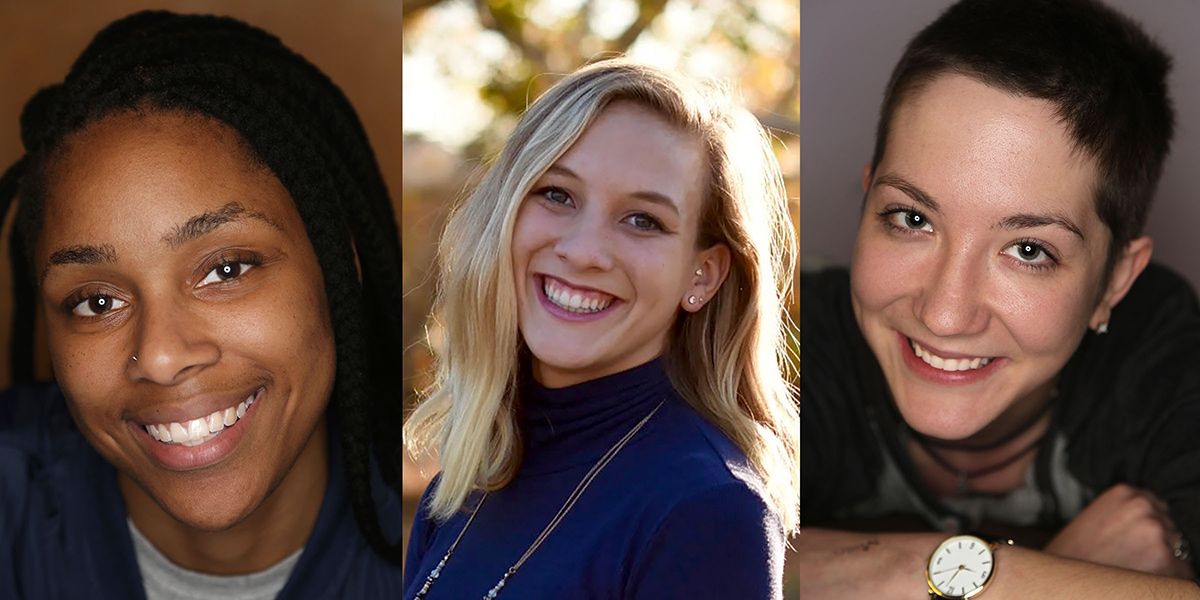
The School of Theatre & Dance’s top annual event, University Dance Theatre, returns March 2 – March 5 in McKenna Theatre featuring guest artist Tanya Chianese’s new work Epoch, alongside new choreography by faculty. SF State’s best dancers perform the entire concert.
The show also highlights three student choreographers: Bridgette Lott, Andrea Ware and Kassidy Friend. Their pieces were selected from the New Moves Choreography Showcase last semester due to “their strong and compelling choreographic skill,” says Lecturer Cathleen McCarthy, University Dance Theatre director.
In between rehearsals, the three student standouts recently discussed their inspirations and challenges.
Please introduce yourselves.
Bridgette Lott: My name is Bridgette Lott and I am in my senior year of college. I have been dancing for six years.
Andrea Ware: My name is Andrea Ware, third-year graduating senior, seven years of dance experience.
Kassidy Friend: My name is Kassidy Friend, this is my fourth year at State, and I have been dancing for 18 years.
Why did you begin dancing at SF State?
BL: The lack of diversity drew me to choreograph. I felt my experience in the dance world is very broad and I wanted to bring a different perspective to the dance department.
AW: I chose to dance at SFSU because San Francisco is an amazing city with a lot of opportunities available for dancers.
KF: I chose SF State in order to gain proximity to San Francisco’s vibrant modern dance scene. I was pleasantly surprised to discover the choreographic emphasis within the dance major. Since choreographing has long been a focus of mine, I eagerly took full advantage of the program.
What inspired you to choreograph your respective pieces for the University Dance Theatre show?
BL: My inspiration for With Reservations comes from a place of personal experience. I found that my fellow dance mates wanted more from the dance department. I wanted more for the dancers. I also was inspired by current events in communities of color. I fused the two to create a piece that displayed social injustices in the world and in the classroom at SFSU.
AW: My piece, If Only, was created as a dedication to a family friend who had committed suicide a few years ago. I wanted to create a piece revolving around the anxiety and tension someone experiences with depression and suicidal temptations.
KF: BINARY comes from my personal experience wrangling the gender binary and discovering my gender identity. However, the themes of this piece can be applied to other binaries within American society. BINARY is also a reflection of the heightened emotional state caused by the current social and political climate.
What’s the hardest challenge when choreographing?
BL: The most challenging thing about choreography is believing in yourself. From my experience, it was most challenging to believe that I could make a successful piece that had an impact on every viewer.
AW: The most challenging thing about choreographing is developing movement that suits other dancers bodies well. I also get caught up with how many ideas I have while choreographing and that makes it hard for me to start and stop a phrase.
KF: Time constraints are always a challenge for me. It is a common struggle among artists, I think, to feel comfortable considering one’s piece to be complete. It is perhaps even harder to present one’s work on the assigned deadline when you do not feel the work to be complete. It seems there is always work to be done.
What’s the most rewarding thing about choreographing?
BL: The most rewarding thing about choreography is the feedback. As I took on the challenge of creating a political piece, the feedback was reassurance that I had done something right.
AW: The most rewarding thing about choreographing is seeing ideas come to life.
KF: To hear my dancers say that the movement is comfortable on their bodies, continuously mentally stimulating and enjoyable to perform. This is what I value most.
What does expressing yourself through dance do for you?
BL: Dance is healing for me. When I dance or choreograph, I feel that I have everyone’s attention. The expression allows me to feel like I have a voice and it is powerful.
AW: Expressing myself through dance connects me to myself and my surroundings. I become very aware of who I am while I dance.
KF: Dance, as with all forms of art, benefits me in a wide variety of ways. Its is therapeutic, mentally invigorating, it pushes my creative limits every day and — most of all — it heals me. To be human is to suffer and to know pain. Art is medicine for the human condition.
Any future projects?
BL: I am an apprentice with Dimensions Dance Theatre in Oakland. We have performances with Black Choreographers Festival, Diamona Coura and at the Oakland Museum of California. Our annual show for the company is in October. I will be dancing with the company throughout our performance season.
AW: I am working on a solo that I will most likely perform at Student Dance Alliance’s No-Tech Fest in May!
KF: Some fellow dance majors and I are in the midst of creating an original piece for Terry Boero’s The Future is Female project. The Future is Female will be performed March 27 and 28 from 7pm to 9:30pm in Creative Arts 104.
— Gospel Cruz
Links
Student choreographers, from left: Bridgette Lott, Andrea Ware and Kassidy Friend. Photos of Bridgette Lott and Kassidy Friend by Gospel Cruz. Photo of Andrea Ware courtesy of Andrea Ware.